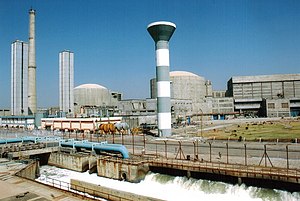Tarapur Atomic Power Station
| Tarapur ←→Atomic Power Station | |
|---|---|
 Unit 3 of Tarapur Atomic Power Station | |
 | |
| Country | India |
| Location | Tarapur, Maharashtra |
| Coordinates | 19°49′44.33″N 72°39′40.34″E / 19.8289806°N 72.6612056°E |
| Status | TAPS-1 and TAPS-2 out of service for 4 years, 8 months TAPS-3 and TAPS-4 operational |
| Construction began | 1961 |
| Commission date | 28 October 1969 |
| Operator | Nuclear Power Corporation of India |
| Nuclear power station | |
| Reactor type | 2 × BWR 2 × PHWR |
| Power generation | |
| Units operational | 2 × 160 MW 2 × 540 MW |
| Nameplate capacity | 1400 MW |
| Capacity factor | 39.4% |
| Annual net output | 4,829 GW·h |
| External links | |
| Commons | Related media on Commons |
Tarapur Atomic Power Station (T.A.P.S.) is located in Tarapur, Palghar, India. It was the first commercial nuclear power station built in India.[1]
History
Tarapur Atomic Power Station was constructed initially with two boiling water reactor (BWR) units under the 1963 123 Agreement between India, the United States, and the International Atomic Energy Agency (IAEA). It was built for the Department of Atomic Energy by GE and Bechtel. Units 1 and 2 were brought online for commercial operation on 28 October 1969 with an initial power of 210 MW of electricity. Later on this was reduced to 160 MW due to technical difficulties.[2] These were the first of their kind in Asia.
More recently, an additional two pressurised heavy water reactor (PHWR) units of 540 MW each were constructed by BHEL, L&T and Gammon India, seven months ahead of schedule and well within the original cost estimates. Unit 3 was brought online for commercial operation on 18 August 2006, and unit 4 on 12 September 2005.[2]
The facility is operated by the NPCIL (Nuclear Power Corporation of India).
The personnel operating the power plant live in a residential complex called T. A. P. S. colony, 19°48′58″N 72°44′35″E / 19.816°N 72.743°E which is a fifteen-minute drive from Boisar, the nearest railway station. The residential complex was also constructed by Bechtel to house both Indian and American employees. Due to this, the residential complex had a very Indian small-town look, with neat sidewalks, spacious houses, a club with tennis courts, swimming pool, a commissary etc. While the original American residents have long gone, the colony continues to thrive.
In 1974 after India conducted Smiling Buddha, its first nuclear weapons test the USA chose to no longer honour its agreement to supply the plant with enriched uranium. Nuclear fuel for TAPS has subsequently been delivered from France, China and Russia under IAEA safeguards.[3]
The residential colony now features 3 central schools run under Atomic Energy Education Society (AEES). The local beach at Chinchani is approximately 7 kilometres (4.3 mi) from the colony.
Units
| Unit | Type | Gross MW | Construction start | Operation start | Notes |
|---|---|---|---|---|---|
| Phase I | |||||
| Tarapur 1 | BWR | 160 | 1 October 1964 | 28 October 1969 | [4] |
| Tarapur 2 | BWR | 160 | 1 October 1964 | 28 October 1969 | [5] |
| Phase II | |||||
| Tarapur 3 | PHWR | 540 | 12 May 2000 | 18 August 2006 | [6] |
| Tarapur 4 | PHWR | 540 | 8 March 2000 | 12 September 2005 | [7] |
Incidents
During the maintenance of TAPS-1, a blast occurred which damaged the chimney. TAPS-2 was subsequently shut down to avoid any potential issues, completely shutting down the power generation capability of Phase-1 of TAPS.[8]
Safety concerns
The Boiling water reactors (BWRs) at Tarapur 1 and 2 units are similar to the reactors involved in the Fukushima Daiichi nuclear disaster. The reactors' age and old design have raised safety concerns and according to one local leader, the two reactors had in 2011 already been in operation for 16 years more than their design lives.[9]
In 2007, Atomic Energy Regulatory Board (AERB) evaluated seismic safety features at Tarapur 1 and 2 and reported many shortfalls, following which NPCIL installed seismic sensors.[10] In 2011, AERB formed a 10-member committee, consisting of experts from Indian Institutes of Technology (IIT) and India Meteorological Department (IMD), to assess the vulnerability of the Tarapur to earthquakes and tsunamis.[11] A. Gopalakrishnan, former director of AERB, said that Tarapur 1 and 2 reactors are much older than the reactors involved in the Fukushima nuclear accident and argued that they should be immediately decommissioned.[12]
See also
References
- ^ PRIS- Power Reactor Information System
- ^ a b "Plants Under Operation - Nuclear Power Corporation of India Limited". Archived from the original on 26 January 2011. Retrieved 20 April 2015.
- ^ "Tarapur Atomic Power Station (TAPS)". Nuclear Threat Initiative. 1 September 2003. Retrieved 18 February 2017.
- ^ "Nuclear Power Reactor Details - TARAPUR-1". Power Reactor Information System. International Atomic Energy Agency (IAEA). 11 February 2020. Retrieved 11 February 2020.
- ^ "Nuclear Power Reactor Details - TARAPUR-2". PRIS. (IAEA). 11 February 2020. Retrieved 11 February 2020.
- ^ "Nuclear Power Reactor Details - TARAPUR-3". PRIS. (IAEA). 11 February 2020. Retrieved 11 February 2020.
- ^ "Nuclear Power Reactor Details - TARAPUR-4". PRIS. (IAEA). 11 February 2020. Retrieved 11 February 2020.
- ^ "No power generation at Tarapur phase I plant after blas cause damage to chimney". MumbaiMirror. Retrieved 29 January 2020.
- ^ O'Halloran, Julian (27 April 2011). "Fears rise in India of Fukushima-style nuclear disaster". BBC News. Retrieved 20 April 2015.
- ^ "Atomic Energy Regulatory Board not quite subatomic". timesofindia-economictimes. Retrieved 20 April 2015.
- ^ "AERB committee forms sub-group to carry Tarapur plant audit". Retrieved 20 April 2015.
- ^ Doubts raised on Tarapur nuclear plant’s safety [dead link]
